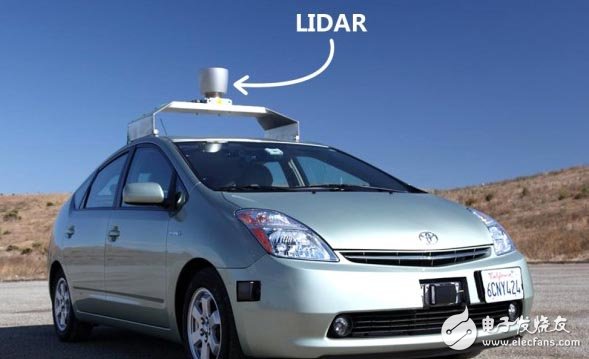Unmanned technology is now very mature. From the current level of technology, if the complex traffic conditions in big cities become laboratory-specific patterns, there are standard vehicles and normal pedestrians in the scene. Then, without the steering wheel, the car that is driving automatically will be available at the moment.
The problem lies in how the car can know the complex traffic conditions in reality and how to be as flexible as the human eye and brain.
The key is to have a variety of sensor cooperation to solve, they will eventually pass the monitored data to high-precision processors, identify roads, signs and pedestrians, and make decisions such as acceleration, steering, and braking.
In the part of IntelliSense recognition, the vehicle optical system and the vehicle radar system are the most important to ensure driving safety. At present, the mainstream sensors for ambient sensing include Lidar, millimeter wave, and vision. Three sensors.

Lidar (LiDAR)
By scanning the laser reflected from an object to determine the distance of the object, a 3D environment map with an accuracy of up to centimeter can be formed, so it plays an important role in ADAS (Advanced Driver Assistance System) and driverless systems. From the current on-board laser radar, mechanical multi-line laser radar is the mainstream solution, but it is not popular because of the high price.
On the road of the Baidu driverless car that was successfully tested on December 10 last year, in addition to the sensors such as millimeter wave radar and video, a large 64-bit laser with a value of more than 700,000 yuan was placed on the roof. radar
(VelodyneHDL64-E), Google also uses the same high-end configuration lidar. The pros and cons of a car-mounted lidar system depends mainly on the performance of the 2D laser scanner. The more laser transmitter harnesses, the more cloud points are collected per second. However, the more harnesses represent the cost of the lidar is more expensive.
Taking Velodyne's products as an example, the price of a 64-line laser radar is 10 times that of a 16-wire bundle. In addition to the high cost of the laser radar, the performance of the smoke medium and the rain and snow weather will be constrained.
But as a core sensor, a low-cost solution will accelerate the arrival of driverless. At present, the manufacturers of high-precision automotive laser radar products are mainly concentrated in foreign countries, including Velodyne, Quanegy in the United States and IBEO in Germany. Domestic laser radar products are relatively backward. Zhou Shining, a senior executive of China Aviation Vehicle Systems Holdings Co., Ltd., said that foreign-owned parts and components companies such as Bosch, China, Valeo, Infineon and Delphi have already seized the commanding heights of ADAS technology, especially in In the market layout of sensors, China's auto parts companies have lost on the starting line.
Millimeter wave radar
The millimeter wave refers to an electromagnetic wave in the frequency domain of 30 to 300 GHz (wavelength of 1 to 10 mm). The wavelength of the millimeter wave is between the centimeter wave and the light wave, so the millimeter wave has the advantages of microwave guidance and photoelectric guidance. Compared with the centimeter wave seeker, the millimeter wave seeker has the characteristics of small size, light weight and high spatial resolution. Compared with optical seekers such as infrared, laser, and television, the millimeter wave seeker has strong ability to penetrate fog, smoke, and dust, and has the characteristics of all-weather (except heavy rain) all-day time, which can be generated by the action of laser radar. Complementary. In addition, the anti-interference and anti-stealth capability of the millimeter wave seeker is superior to other microwave seekers.

The disadvantage is that millimeter-wave radars have very limited detection range due to wavelength, and they cannot sense pedestrians. Lidar can accurately model all obstacles around it. In order to overcome the shortcomings of different shortcomings, it is necessary for the car to combine these sensors.
At present, the millimeter wave radar is also the standard sensor of the intelligent car ADAS system. According to the current mainstream classification, the millimeter wave radar can be divided into 24 GHz radar and 77 GHz radar. Referring to its characteristics, the vehicle around the vehicle is usually detected using 24Ghz, and the vehicle in front is detected using 77GHz. In terms of China's actual national conditions and the progress of chip research and development, the 24GHz millimeter wave radar still has market space in China in the next three years. Looking at the world, the large-scale application of China's 77GHz millimeter wave radar will be slightly pushed back.
Because the function of ADAS is often bundled and sold by means of sensors + processors, the chips and algorithms of domestic automotive millimeter wave radar systems are mainly dependent on imports, and the cost is high. Accelerating the development of the domestically produced 77GHZ millimeter wave radar chip and on-board application as soon as possible will be an opportunity for China's automotive millimeter wave radar industry. Professor Bai Jie from the Automotive College of Tongji University believes that compared with the fierce competition in the camera, the millimeter wave radar is more innovative, with more potential market space and more opportunities.
Chuangying Electronics Co.,Ltd , https://www.cwpcb.com